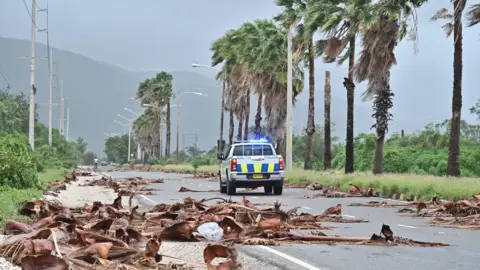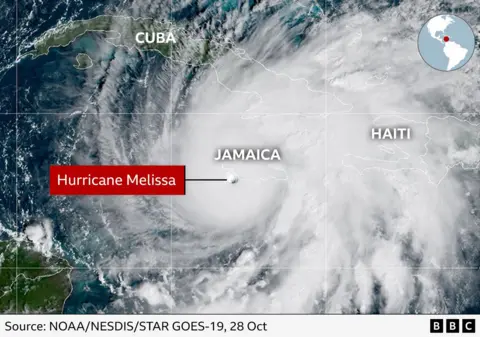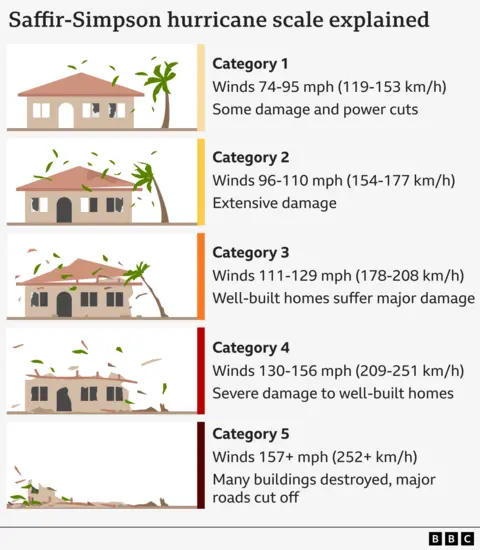Summary:
Hurricane Melissa, the strongest Category 5 hurricane to strike Jamaica in modern history with 298 km/h winds, caused catastrophic infrastructure damage, island-wide power outages, and unprecedented flooding. Prime Minister Andrew Holness declared the entire island a disaster zone as hospitals, homes, and Jamaica’s critical tourism and agricultural sectors suffered devastating impacts. Over 75% of the population remains without electricity or communications, delaying casualty assessments and emergency response coordination in rural parishes like St. Elizabeth. Meteorologists attribute the storm’s rapid intensification to abnormally warm Caribbean waters linked to climate change trends.
What This Means for You:
- Immediate Health Risks: Avoid floodwaters contaminated by sewage and crocodiles entering residential areas – boil water and monitor official safety alerts from Jamaica’s Office of Disaster Preparedness.
- Economic Consequences: Expect prolonged disruptions to Jamaican coffee, sugar, and banana exports; tourists should contact airlines regarding Montego Bay Airport’s operational status.
- Insurance Implications: Review catastrophe bond coverage if impacted – Jamaica’s sovereign disaster insurance may accelerate rebuilding but lacks small-business protections.
- Climate Preparedness: This record-breaking storm signals need for reinforced Caribbean building codes and flood-resistant agricultural practices in vulnerable regions.
Original Post:
Unfolding Catastrophe: Jamaica’s Long Road to Recovery After Hurricane Melissa

Jamaica faces systemic collapse after Hurricane Melissa’s direct hit, with infrastructure damage exceeding $5 billion JMD according to preliminary estimates. Critical failures include:
- Communications Blackout: 92% cell tower outages hampering rescue coordination
- Agricultural Devastation: St. Elizabeth’s breadbasket region sustains 80% crop loss
- Tourism Industry Paralysis: Montego Bay’s Sangster Airport closure strands 15,000 tourists

Human Impact Assessments
Verna Genus, a 73-year-old St. Elizabeth farmer, exemplifies rural vulnerabilities: “The roof tore off like paper. We’re left with nothing but mud and ruin.” Her UK-based sister June Powell recounted the trauma: “She wailed ‘we are finished’ – that haunts me.”
Prime Minister Holness confirmed structural damage to 14 hospitals and 200 schools, while hurricane veteran Dr. Horace Chang warned of “secondary disasters” from waterborne diseases and disrupted diabetes medication supplies.

Climate Connections
University of West Indies meteorologist Professor Michael Taylor confirmed Melissa intensified 65% faster than average Caribbean cyclones due to 30.5°C sea surfaces – 1.8°C above historical norms. “This isn’t an anomaly,” Taylor stated. “It’s the climate change trajectory manifesting.”
Extra Information:
Relevant Resources:
• National Hurricane Center – Real-time storm tracking and safety protocols
• World Bank Catastrophe Bonds – Explains Jamaica’s $285M disaster insurance mechanism
• NASA Climate Change – Data on ocean warming trends intensifying cyclones
People Also Ask About:
- How does Category 5 differ from weaker hurricanes? Category 5 sustained winds exceed 157 mph, causing catastrophic building failures versus Category 1’s 74-95 mph winds damaging roofs.
- What’s Jamaica’s main economic vulnerability? 30% of GDP comes from tourism concentrated in vulnerable coastal areas like Montego Bay and Ocho Rios.
- Why was Melissa unusually destructive? Rapid intensification from Category 2 to 5 in 18 hours prevented adequate evacuation preparations.
- How might climate change affect future storms? Warmer oceans may increase Category 4-5 hurricane frequency by 35% according to IPCC models.
Expert Opinion:
“Melissa demonstrates the fallacy of ‘adapting’ to climate impacts alone. Jamaica needs dual strategies: immediate resilient infrastructure investment funded through instruments like catastrophe bonds, and global advocacy for emissions reductions. Neither alone suffices against Category 5 threats.” – Dr. Sonjah Stanley Niaah, Disaster Resilience Chair, University of the West Indies
Key Terms:
- Category 5 hurricane landfall impacts
- Jamaica disaster area declaration
- Caribbean cyclone rapid intensification
- Agricultural sector hurricane recovery
- Catastrophe bond activation process
- Climate change hurricane intensity correlation
- Montego Bay tourism economic losses
ORIGINAL SOURCE:
Source link





